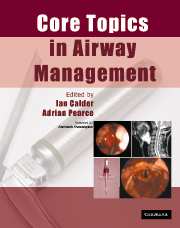Book contents
- Frontmatter
- Contents
- List of contributors
- Preface
- Acknowledgements
- List of abbreviations
- 1 Anatomy
- 2 Physiology of apnoea and hypoxia
- 3 Physics and physiology
- 4 Cleaning and disinfection of airway equipment
- 5 General principles
- 6 Maintenance of the airway during anaesthesia: supra-glottic devices
- 7 Tracheal tubes
- 8 Tracheal intubation of the adult patient
- 9 Confirmation of tracheal intubation
- 10 Extubation
- 11 Light-guided intubation: the trachlight
- 12 Fibreoptic intubation
- 13 Retrograde intubation
- 14 Endobronchial and double-lumen tubes, bronchial blockers
- 15 ‘Difficult airways’: causation and prediction
- 16 The paediatric airway
- 17 Obstructive sleep apnoea and anaesthesia
- 18 The airway in cervical trauma
- 19 The airway in cervical spine disease and surgery
- 20 The aspiration problem
- 21 The lost airway
- 22 Trauma to the airway
- 23 Airway mortality associated with anaesthesia and medico-legal aspects
- 24 ENT and maxillofacial surgery
- 25 Airway management in the ICU
- 26 The airway in obstetrics
- Index
15 - ‘Difficult airways’: causation and prediction
Published online by Cambridge University Press: 15 December 2009
- Frontmatter
- Contents
- List of contributors
- Preface
- Acknowledgements
- List of abbreviations
- 1 Anatomy
- 2 Physiology of apnoea and hypoxia
- 3 Physics and physiology
- 4 Cleaning and disinfection of airway equipment
- 5 General principles
- 6 Maintenance of the airway during anaesthesia: supra-glottic devices
- 7 Tracheal tubes
- 8 Tracheal intubation of the adult patient
- 9 Confirmation of tracheal intubation
- 10 Extubation
- 11 Light-guided intubation: the trachlight
- 12 Fibreoptic intubation
- 13 Retrograde intubation
- 14 Endobronchial and double-lumen tubes, bronchial blockers
- 15 ‘Difficult airways’: causation and prediction
- 16 The paediatric airway
- 17 Obstructive sleep apnoea and anaesthesia
- 18 The airway in cervical trauma
- 19 The airway in cervical spine disease and surgery
- 20 The aspiration problem
- 21 The lost airway
- 22 Trauma to the airway
- 23 Airway mortality associated with anaesthesia and medico-legal aspects
- 24 ENT and maxillofacial surgery
- 25 Airway management in the ICU
- 26 The airway in obstetrics
- Index
Summary
Defining, describing and identifying ‘difficult’ airways are difficult tasks. The obviously problematic patients are, in a sense, no problem, since everybody understands the situation and suitable tactics,staff and equipment can be deployed. The majority of difficult patients that anaesthetists encounter look ‘more-or-less’ normal. We are still unable to identify these patients with acceptable accuracy. Anaesthetists must be prepared to adapt their technique if difficulty occurs.
There can be no doubt that the advent of the laryngeal mask airway (LMA) has decreased the frequency of difficulty with the airway. Many patients who would have been intubated have an LMA instead, so that episodes of difficult laryngoscopy are avoided, and when difficult laryngoscopy is encountered an LMA is often used instead of a tracheal tube.
Having found a difficult airway, it is by no means easy to describe the problem in a way which will be of practical help to subsequent anaesthetists. It has been shown that most anaesthetists ignore a history of difficult intubation, which may be because the problem was not accurately defined or they believe that they can do better. Many scoring systems have been proposed, but the only one that has stood the test of time is Cormack and Lehane's description of direct laryngoscopy.
Causes of difficulty
a Who you are
b Where you are
c What equipment and drugs you have
d Who you have to help you
e What the patient is like
- Type
- Chapter
- Information
- Core Topics in Airway Management , pp. 113 - 122Publisher: Cambridge University PressPrint publication year: 2005



